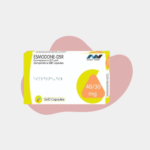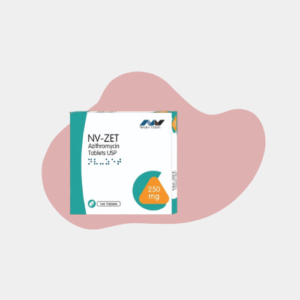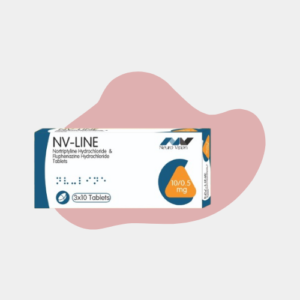Description
NEPRAM-10MG TABLETS
1. Escitalopram Oxalate USP Eq. to Escitalopram 10mg:
Escitalopram Oxalate is a salt form of the medication Escitalopram. In pharmaceuticals, sometimes drugs are formulated in salt forms because they are more stable or easier to absorb.
USP stands for the United States Pharmacopeia, which sets the standards for the purity, strength, and quality of medicines. This ensures the medication meets specific guidelines.
The 10 mg refers to the amount of Escitalopram that will be effective in the body after taking the tablet. Even though the tablet contains Escitalopram Oxalate, the equivalent amount of the active compound (Escitalopram) is 10 mg.
2. Pharmacokinetic:
Pharmacokinetics explains the journey of the drug within the body and how it is handled by various organs.
Absorption: After you take the tablet, Escitalopram is absorbed into your bloodstream through the stomach and intestines. The time it takes to absorb and the extent to which it is absorbed affect how quickly it starts working.
Distribution: Once in the bloodstream, Escitalopram is distributed throughout the body, including the brain, where it is needed for its effects.
Metabolism: Escitalopram is processed by the liver, primarily by enzymes like CYP2C19, CYP3A4, and CYP2D6. These enzymes break the drug down into metabolites (products of metabolism), some of which may also have therapeutic effects.
Excretion: The drug and its metabolites are eliminated from the body, mostly through the kidneys in urine. Understanding how long the drug stays in the body helps doctors decide how often it should be taken.
3. Pharmacodynamic:
Pharmacodynamics focuses on what the drug does to the body — in this case, Escitalopram works by increasing serotonin levels in the brain.
Serotonin is a neurotransmitter that plays a key role in mood regulation, emotional stability, and overall mental well-being.
Escitalopram works by blocking the reabsorption (or reuptake) of serotonin in the brain, making more serotonin available to transmit signals between nerve cells. This helps improve mood and reduce symptoms of anxiety and depression.
4. Key Used:
Escitalopram is used to treat:
Major depressive disorder (MDD): A chronic condition characterized by a persistent low mood and loss of interest in daily activities.
Generalized anxiety disorder (GAD): A condition marked by excessive worry, nervousness, or fear that is difficult to control.
Panic disorder: A condition that involves recurrent, unexpected panic attacks (sudden intense episodes of fear).
Social anxiety disorder: Intense fear of being judged or negatively evaluated in social situations.
Sometimes, doctors may prescribe Escitalopram for Obsessive-Compulsive Disorder (OCD) or Post-Traumatic Stress Disorder (PTSD).
5. Special Work:
This could include any special mechanisms or circumstances around the use of Escitalopram.
Start-up effects: Some patients may experience side effects like nausea or sleep disturbances at the beginning of treatment, but these usually subside after the body adjusts to the medication.
Adjustment for specific populations: The dosage may need to be adjusted in elderly patients, individuals with liver or kidney problems, or those who are taking other medications that might interact with Escitalopram.
6. Side Effect:
Side effects are unwanted or unexpected symptoms that occur when taking a medication. Common side effects of Escitalopram include:
Nausea, vomiting, or diarrhea: These can occur as the body adjusts to the medication.
Fatigue, dizziness, or sleep problems: Some people feel drowsy or experience difficulty sleeping when they first start Escitalopram.
Sexual side effects: This can include reduced libido, erectile dysfunction, or difficulty achieving orgasm. These effects may continue during treatment.
Weight changes: Some individuals may gain or lose weight during treatment with Escitalopram.
Serotonin syndrome: Although rare, this is a potentially life-threatening condition that can occur if serotonin levels become too high. Symptoms include agitation, confusion, rapid heart rate, and high blood pressure.
Suicidal thoughts: In some cases, especially in young adults or adolescents, Escitalopram can increase the risk of suicidal thoughts, particularly during the initial treatment phase.
7. Benefits:
Escitalopram’s benefits focus on improving mental health. It helps people who suffer from depression or anxiety to feel more stable and less overwhelmed by their symptoms.
Reduced anxiety: Escitalopram can help reduce the excessive fear and worry characteristic of anxiety disorders.
Improved mood: For people with depression, Escitalopram can help elevate mood and make daily functioning easier.
Fewer panic attacks: For individuals with panic disorder, it can reduce the frequency and severity of panic attacks.
Better quality of life: By alleviating the symptoms of these mental health conditions, patients may be able to engage more effectively in work, social, and family activities.
8. Other:
In this section, additional information that may be important for prescribing and using the drug is provided:
Dosage guidelines: Typically, Escitalopram is started at a low dose (e.g., 10 mg/day), and this may be adjusted based on the patient’s response and tolerability. For example, the dose might be increased to 20 mg/day after a few weeks.
Drug interactions: Escitalopram can interact with other medications, particularly those that affect serotonin levels (like other antidepressants or certain pain medications), increasing the risk of serotonin syndrome.
Precautions: Individuals with liver disease, kidney disease, or those who are pregnant or breastfeeding may need special monitoring or a modified dosage.
Storage: It’s important to store the medication at room temperature and away from moisture to preserve its effectiveness.
In summary, each part of this table provides essential information about Escitalopram Oxalate (the active drug), how it works, its therapeutic uses, possible side effects, and special considerations when using the medication. Understanding each of these components helps healthcare providers make informed decisions about the appropriate treatment for their patients.







Reviews
There are no reviews yet.